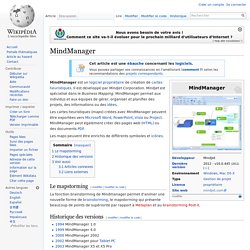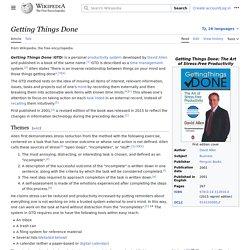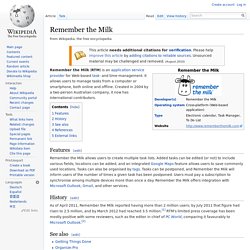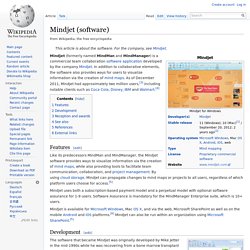

MindManager. Un article de Wikipédia, l'encyclopédie libre.

MindManager est un logiciel propriétaire de création de cartes heuristiques. Il est développé par Mindjet Corporation. Mindjet est spécialisé dans le Business Mapping. MindManager permet aux individus et aux équipes de gérer, organiser et planifier des projets, des informations ou des idées. Les cartes heuristiques (maps) créées avec MindManager peuvent être exportées vers Microsoft Word, PowerPoint, Visio ou Project. Le mapstorming[modifier | modifier le code] La fonction brainstorming de Mindmanager permet d'animer une nouvelle forme de brainstorming, le mapstorming qui présente beaucoup de points de supériorité par rapport à Metaplan et au brainstorming Post-it. Historique des versions[modifier | modifier le code] MindManager tourne actuellement sous Microsoft Windows et Mac OS X.
Hipster PDA. Although it began as a joke, or perhaps a statement about technology fetishism, the Hipster PDA has rapidly gained popularity with serious users,[4] with hundreds posting pictures of their customized hPDAs on photo sharing sites and exchanging tips on Internet mailing lists.

Advocates of the hPDA claim that it is a cheap, lightweight, freeform organizer[5] that doesn't need batteries and is unlikely to be stolen. Enthusiasts also design and share index-card-size printable templates for storing contacts, to-do lists, calendars, notes, project plans, and so on. A Hipster Nano PDA utilizes business cards with blank backs and one that has a calendar on the back. Getting Things Done. The GTD method rests on the idea of moving planned tasks and projects out of the mind by recording them externally and then breaking them into actionable work items.

This allows attention to be focused on taking action on tasks, instead of recalling them.[2] First published in 2001, a revised edition of the book was released in 2015 to reflect the changes in information technology during the preceding decade. Themes[edit] Allen first demonstrates stress reduction from the method with the following exercise, centered on a task that has an unclear outcome or whose next action is not defined.
Allen calls these sources of stress "open loops", "incompletes", or "stuff".[1]:13 He claims stress can be reduced and productivity increased by putting reminders about everything you are not working on into a trusted system external to your mind. Pomodoro Technique. A Pomodoro kitchen timer, after which the method is named The Pomodoro Technique is a time management method developed by Francesco Cirillo in the late 1980s.[1] The technique uses a timer to break down work into intervals, traditionally 25 minutes in length, separated by short breaks.
Each interval is known as a pomodoro, from the Italian word for 'tomato', after the tomato-shaped kitchen timer that Cirillo used as a university student.[2][3] The technique has been widely popularized by dozens of apps and websites providing timers and instructions. Closely related to concepts such as timeboxing and iterative and incremental development used in software design; the method has been adopted in pair programming contexts.[4] Description[edit] There are six steps in the original technique: For the purposes of the technique, a pomodoro is the interval of time spent working.[1] After task completion in a pomodoro, any time remaining could be devoted to activities such as: Cirillo suggests: Category:Time management. Remember the Milk. Remember the Milk (RTM) is an application service provider for Web-based task- and time-management.

It allows users to manage tasks from a computer or smartphone, both online and offline. Created in 2004 by a two-person Australian company, it now has international contributors. Mindjet (software) This article is about the software.

For the company, see Mindjet. Like its predecessors MindMan and MindManager, the Mindjet software provides ways to visualize information via the creation of mind maps, while also providing tools to facilitate team communication, collaboration, and project management. By using cloud storage, Mindjet can propagate changes to mind maps or projects to all users, regardless of which platform users choose for access.[5] Mindjet uses both a subscription-based payment model and a perpetual model with optional software assurance for 1-9 users.
Software Assurance is mandatory for the MindManager Enterprise suite, which is 10+ users. A screenshot of Mindmanager 8 The software that became Mindjet was originally developed by Mike Jetter in the mid-1990s while he was recovering from a bone marrow transplant to treat leukemia. While still branded as MindManager, Mindjet received generally positive notice from reviewers. Official website.